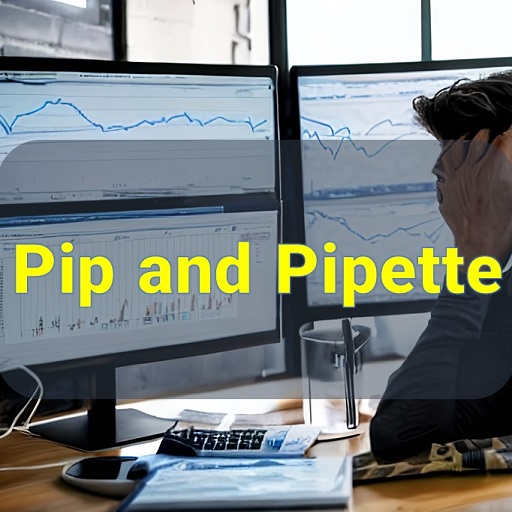In the vast world of forex trading, the concepts of pip and pipette play a crucial role. These terms are used to measure and express the changes in currency pairs’ value. Traders rely on them to assess profits, losses, and overall market movements. Understanding the significance of pip and pipette is essential for anyone involved in forex trading. This article will provide a comprehensive overview of pip and pipette, explaining their definitions, calculations, and applications.
What is Pip?
Pip stands for “Percentage in Point” or “Price Interest Point.” It represents the smallest unit of measurement for currency price movements. For most major currency pairs, a pip is equivalent to 0.0001. However, for currency pairs involving the Japanese yen, a pip represents 0.01 due to the yen’s lower value compared to other major currencies.
How Pip Works in Forex Trading
Here’s how pips function in forex trading:
1. Pip Value: The value of a pip depends on the currency pair being traded and the size of the position. For most major currency pairs, a pip is equal to 0.0001 of the quoted price, except for currency pairs involving the Japanese yen, where a pip is equal to 0.01. So, for example, if the EUR/USD currency pair moves from 1.2000 to 1.2001, it has moved one pip.
2. Measuring Price Movements: Pips allow traders to measure and track price movements in the forex market. Traders analyze charts and monitor the number of pips that a currency pair has moved to identify trends, assess market volatility, and make trading decisions based on their strategies.
3. Calculating Profit and Loss: Pips are used to calculate the profits and losses of forex trades. When a trade is executed, the profit or loss is determined by the number of pips gained or lost. For example, if a trader buys the EUR/USD currency pair at 1.2000 and sells it at 1.2010, they have gained 10 pips. The monetary value of these pips depends on the size of the position and the currency pair being traded.
4. Pipettes: In addition to pips, there is another unit of measurement called pipettes, which represent fractional pips. A pipette is equal to one-tenth of a pip. It is often used to provide more precise measurements and calculations. For example, if the EUR/USD currency pair moves from 1.20000 to 1.20001, it has moved one pipette.
5. Spread and Transaction Costs: The spread is the difference between the bid and ask prices of a currency pair. It is usually measured in pips. When entering a trade, traders need to consider the spread as it represents the cost of executing the trade. The spread is an important factor to consider when calculating potential profits and losses.
6. Pip Movement and Position Sizing: The movement of pips in a currency pair indicates the potential profit or loss on a trade. Traders can use the concept of pip movement to determine suitable position sizes based on their risk management strategy. By considering the pip value and the desired risk percentage, traders can calculate the appropriate position size to limit potential losses.
Understanding how pips work is fundamental to forex trading. It enables traders to measure price movements, calculate profits and losses, consider transaction costs, and determine suitable position sizes. By effectively utilizing pip calculations, traders can manage their risk, make informed trading decisions, and ultimately improve their trading performance.
Calculating Pip Value
To calculate the monetary value of a pip, traders need to consider the lot size and the exchange rate of the currency pair. The formula to calculate the pip value is as follows:
Pip Value = (Pip in decimal places / Exchange Rate) * Lot Size
Importance of Pip in Forex Trading
Here are some key reasons why pips are important in forex trading:
1. Price Quotes: Forex currency pairs are quoted with two prices: the bid price (selling price) and the ask price (buying price). The difference between these two prices is measured in pips. Traders use pips to analyze price movements, identify trends, and make trading decisions.
2. Profit and Loss Calculation: Pips are essential for calculating profits and losses in forex trading. When a trade is executed, the price will fluctuate, and the profit or loss will be determined by the number of pips gained or lost. Traders use pip values to determine the potential risk and reward of a trade.
3. Position Sizing: Pip values are crucial in determining the appropriate position size for a trade. By considering the pip value, traders can control their risk and adjust their position sizes accordingly. Proper position sizing is crucial for risk management and maintaining a balanced trading strategy.
4. Spread and Transaction Costs: The spread is the difference between the bid and ask prices. It is typically measured in pips and represents the cost of executing a trade. Traders need to consider the spread when entering and exiting positions, as it directly affects their overall profitability.
5. Setting Stop Loss and Take Profit Levels: Stop loss and take profit orders are used to manage risk and secure profits. Traders often set these orders based on specific pip distances from the entry price. Understanding the pip value helps traders determine suitable levels for stop loss and take profit orders, considering their risk-reward ratios.
6. Pip Movement and Volatility: Pips also provide insights into market volatility. Higher pip movements indicate greater volatility, while smaller pip movements suggest lower volatility. Traders use this information to gauge potential risks, adjust their trading strategies, and identify suitable currency pairs to trade based on their risk tolerance.
In conclusion, pips play a vital role in forex trading. They are fundamental for calculating profits, losses, determining position sizes, managing risk, and analyzing market volatility. Having a solid understanding of pips and their significance is crucial for successful forex trading.
What is Pipette?
Pipette is a fractional pip or a sub-unit of a pip. It represents a smaller increment in price movement compared to a pip. While a pip is generally equal to 0.0001, a pipette is equal to 0.00001. The introduction of pipettes allows for more precise price quoting, especially in highly volatile markets.
Pipette and Its Role in Forex Trading
Similar to pip, pipette measures fractional price changes in currency pairs. It provides traders with a finer level of precision when analyzing market movements and determining trade outcomes. By incorporating pipettes, forex brokers offer more accuracy and flexibility to their clients, particularly during times of increased market activity.
Calculating Pipette Value
Calculating the pipette value follows the same principles as calculating the pip value. However, since a pipette is one-tenth the size of a pip, the decimal places in the formula change accordingly. The revised formula for pipette value calculation is as follows:
Pipette Value = (Pipette in decimal places / Exchange Rate) * Lot Size
Significance of Pipette in Forex Trading
Pipette enables traders to evaluate smaller price movements and make precise trading decisions. In highly volatile markets, where price fluctuations can be substantial, pipettes provide enhanced accuracy in assessing potential profits or losses. Traders who utilize pipettes have the advantage of finer granularity in their trade executions and risk management strategies.
Key Differences Between Pip and Pipette
Here are the key differences between pip and pipette:
1. Definition: A pip is the smallest incremental movement in the price of a currency pair, typically measured to the fourth decimal place. It represents the fourth digit after the decimal point, except for currency pairs involving the Japanese yen, where it represents the second digit after the decimal point. On the other hand, a pipette is a fractional pip, also known as a “fractional pip” or “point,” and represents the fifth decimal place for most currency pairs.
2. Size: The size of a pip is generally larger than that of a pipette. A pip is usually equal to 0.0001 for most currency pairs, except for yen-based pairs, where it is equal to 0.01. In contrast, a pipette is equal to 0.00001, which is one-tenth the size of a pip.
3. Precision: Pips are typically used when quoting currency pairs, while pipettes are commonly employed in more precise calculations and price quotes. When brokers provide price quotes, they often display the bid and ask prices in pipettes, allowing for more accurate measurements and calculations.
4. Profit and Loss Calculation: Pips are commonly used to calculate profits and losses in forex trading. When a trade moves in favor of a trader by one pip, it means the trader has gained or lost a certain amount based on the position size. Pipettes, however, offer even greater precision when calculating profits and losses, especially in cases where trades involve smaller price movements.
5. Spread Measurement: The spread, which is the difference between the bid and ask prices, is often measured in pips. For example, if the bid price is 1.2000 and the ask price is 1.2005, the spread would be 5 pips. Pipettes can also be used to measure spreads with greater precision, allowing for more accurate evaluation of transaction costs.
6. Quoting Convention: The quoting convention for currency pairs often involves pips. For instance, if the EUR/USD pair is quoted at 1.2500, a movement to 1.2501 would represent a one-pip increase. In some cases, brokers may quote currency pairs using fractional pips or pipettes to provide more detailed information on price movements.
In summary, while both pip and pipette are units of measurement in forex trading, they differ in terms of size, precision, and their specific applications. Pips are more commonly used for general price quotes, profit/loss calculations, and spread measurement, while pipettes offer greater precision and are useful for more accurate calculations and price quoting in highly precise scenarios.
Pip and Pipette in Trading Strategies
Pips and pipettes play important roles in various trading strategies. Here’s how they are utilized in different trading approaches:
1. Scalping: Scalping is a short-term trading strategy that aims to profit from small price movements. Traders employing this strategy often target a few pips or pipettes of profit per trade. The precision provided by pipettes allows scalpers to enter and exit positions based on smaller price differentials, maximizing their potential gains within a limited time frame.
2. Day Trading: Day traders execute trades within a single trading day, seeking to capture intraday price fluctuations. Pips and pipettes are crucial in setting profit targets and stop-loss levels. Day traders may establish profit targets based on a specific number of pips, ensuring they secure profits when the market moves in their favor. Additionally, stop-loss orders are often placed a few pips or pipettes away from the entry price to limit potential losses.
3. Swing Trading: Swing traders aim to capture larger price movements over a few days to weeks. Pip and pipette values provide important insights when identifying potential swing trade setups. Traders analyze historical price patterns, support and resistance levels, and other technical indicators to determine the optimal entry and exit points for their trades. Pip and pipette measurements help them set appropriate profit targets and manage risk through stop-loss orders.
4. Range Trading: Range trading involves identifying and trading within specific price ranges where the market shows consolidation. Traders utilizing this strategy may focus on trading within a defined range of pips or pipettes. They aim to profit from multiple smaller moves within the range rather than relying on significant price breakthroughs. The precision offered by pipettes enables traders to identify potential entry and exit points more accurately.
5. Breakout Trading: Breakout traders aim to profit from significant price movements that occur when price breaks out of a consolidation phase or a defined range. Pip and pipette measurements help traders set entry and exit levels when a breakout occurs. They may establish entry orders a few pips or pipettes above or below key levels to confirm the breakout and enter trades accordingly.
6. Position Sizing: Pip and pipette values are critical in determining position sizes based on risk management principles. Traders use the pip or pipette value, along with their risk tolerance and account size, to calculate the appropriate position size for each trade. This ensures that the potential loss, measured in pips or pipettes, remains within their predefined risk limits.
It’s important to note that the specific use of pips and pipettes may vary depending on the trader’s individual strategy, trading style, and risk management approach. Traders should adapt their strategies to incorporate these units of measurement based on their trading goals and the characteristics of the currency pairs they are trading.
Risk Management and Pipette
Risk management is a crucial aspect of trading, and pipettes play a significant role in effectively managing risk. Here’s how pipettes are utilized in risk management strategies:
1. Stop Loss Placement: Stop loss orders are essential tools used to limit potential losses on a trade. Traders determine stop loss levels by considering factors such as support and resistance levels, technical indicators, and volatility. Pipettes provide greater precision when setting stop loss levels, enabling traders to place their stop loss orders at specific price levels, ensuring that they are triggered before the market moves against their positions by a predefined number of pipettes.
2. Risk-Reward Ratio: The risk-reward ratio helps traders assess the potential profitability of a trade in relation to the risk undertaken. Pipettes are utilized in determining the distance between the entry point and the target profit level. By setting specific profit targets in terms of pipettes, traders can calculate the potential reward in relation to the risk they are willing to take, allowing them to make informed decisions about whether a trade aligns with their risk management objectives.
3. Position Sizing: Pipettes are also employed in determining the appropriate position size for a trade, considering the trader’s risk tolerance and the distance to the stop loss level. By defining the maximum number of pipettes they are willing to risk on a trade, traders can calculate the position size that aligns with their risk management strategy. This ensures that the potential loss, measured in pipettes, remains within their predefined risk limits.
4. Volatility Consideration: Pipettes play a role in managing risk in volatile market conditions. Higher volatility implies larger price movements, which can increase the risk of adverse price swings. By factoring in pipettes when assessing volatility, traders can adjust their position sizes and set wider stop loss levels to account for increased market fluctuations. This helps protect their capital from being excessively exposed to potentially volatile price movements.
5. Trade Adjustments: Pipettes also aid in making trade adjustments when necessary. If a trade is not progressing as anticipated, traders may decide to modify their stop loss levels or take partial profits based on specific pipette movements. This flexibility allows traders to adapt their risk management strategy as the market evolves, ensuring they protect their capital and optimize their trading outcomes.
In summary, pipettes are valuable in risk management strategies as they provide greater precision for setting stop loss levels, calculating risk-reward ratios, determining position sizes, considering market volatility, and making trade adjustments. By incorporating pipettes into their risk management practices, traders can effectively manage and control the potential risks associated with their trades, ultimately enhancing their overall trading performance.
Conclusion
Understanding the concepts of pip and pipette is essential for successful forex trading. These units of measurement enable traders to gauge price movements, calculate potential profits or losses, and implement effective risk management strategies. By grasping the significance of pip and pipette, traders can make informed decisions and navigate the forex market with confidence.
FAQs
1. What is the minimum pip movement for major currency pairs?
– The minimum pip movement for major currency pairs is generally 0.0001.
2. How can I calculate the pip value for exotic currency pairs?
– To calculate the pip value for exotic currency pairs, use the same formula as for major currency pairs, considering the appropriate decimal places.
3. Are pip and pipette the same in every forex broker?
– Pip and pipette may vary slightly between forex brokers. It is advisable to check the broker’s trading specifications to understand their specific pip and pipette values.
4. Can I trade forex without understanding pip and pipette?
– Understanding pip and pipette is crucial for successful forex trading. It is recommended to familiarize yourself with these concepts to effectively analyze market movements and make informed trading decisions.
5. Is it possible to make profits solely based on pip movements?
– While pip movements are essential in determining profits or losses, successful forex trading requires a comprehensive approach that considers multiple factors such as market analysis, risk management, and trading strategies.







